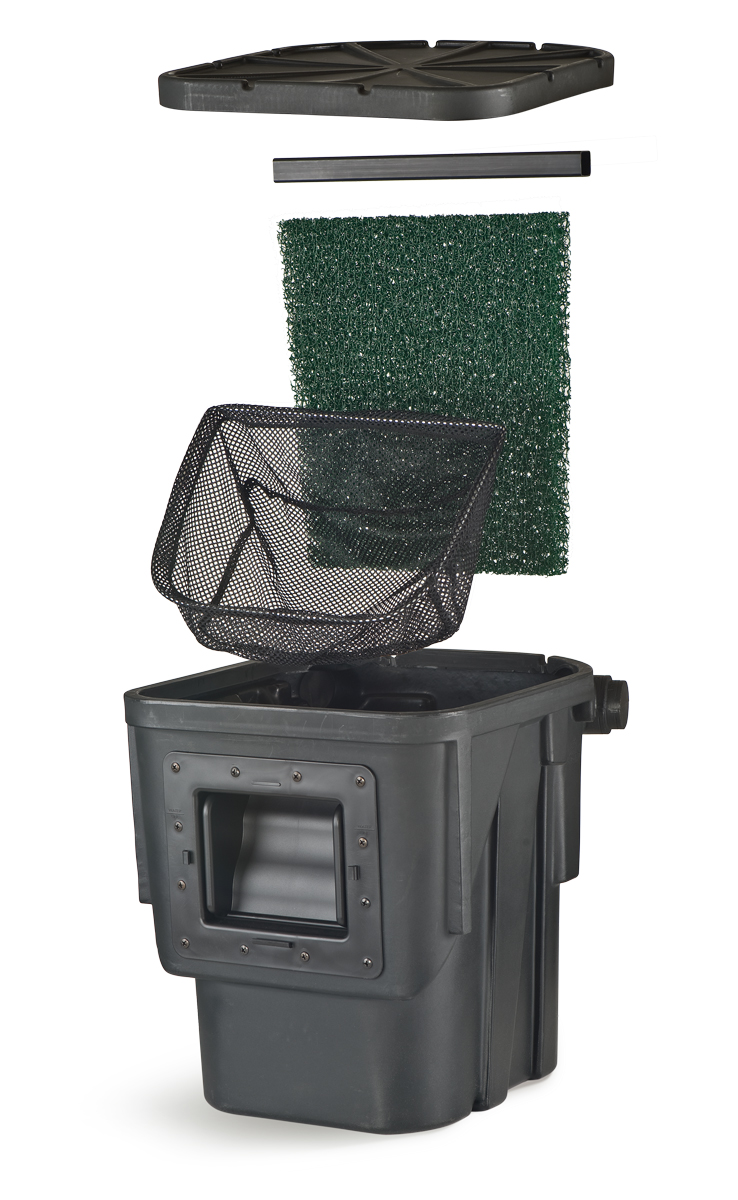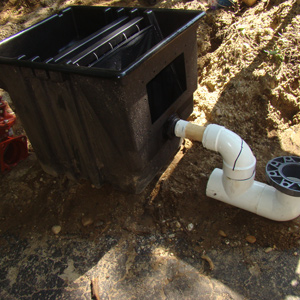Mechanical Filtration 101 Chapter 3
The Ultimate Prefilter: The Pond Skimmer

Prefilterscan be made in any size or shape, with or without additional filtration media, but all share at least one feature – in general, the larger the prefilter, the less maintenance. Increase the total screened surface area feeding the pump and the prefilter will take longer to clog, so the pump can go longer between cleanings. The apex of mechanical prefiltration is the Pond Skimmer, where the prefilter is so large that the whole pump sits inside of it, instead of being attached to the pump intake. This arrangement typically keeps pumps going longer between cleanings, is so much easier to clean and so much more versatile than in-pond prefilters that it has become, for many people, the standard equipment for ponds.
The reasons why Skimmers now dominate the pond building scene are many. Skimmers house and protect pumps at the edge of the pond, where they can be easily accessed and maintained. The Skimmer is usually (not always) buried outside the pond perimeter, so it can be generously sized without taking away from the pond volume, and that means lots of room for prefiltration, if properly designed. In addition to (hopefully) keeping the junk out of your pump, a good, well-placed Skimmer mated to the right size pump can remove almost all floating debris before it can sink, greatly reducing the organic load in the pond (which is the stuff that feeds algae, among other things).

You should also be aware that there are situations when Skimmers may make pond filtration more difficult, specifically when skimming is the only method of prefiltration in fish ponds stocked with Nishiki-goi, otherwise known as Koi. This school of thought observes that Skimmers are ineffective at removing the copious quantities of fish ‘mulm’ (poo) that sink to the bottom far from the reach of the Skimmer weir, necessitating other removal methods. Some fishkeepers would rather liquefy the muck, passing it through a pump sitting on the bottom of the pond and pumping the nasty slurry up into a biofilter. Others greatly prefer the more sophisticated (and costly) idea of siphoning off the intact wastes through bottom drains into settling tanks, removing the organic poo and goo before passing the rest of the water through filtration. We’ll go into both of these filtration techniques later on, but for now, it should be noted that Skimmers don’t necessarily need to be excluded from either design. Many of the more versatile and well-designed Skimmers can actually be plumbed directly to bottom drains, and collected wastes can either settle out in the Skimmer or be pumped to a biofilter.

Prefilterscan be made in any size or shape, with or without additional filtration media, but all share at least one feature – in general, the larger the prefilter, the less maintenance. Increase the total screened surface area feeding the pump and the prefilter will take longer to clog, so the pump can go longer between cleanings. The apex of mechanical prefiltration is the Pond Skimmer, where the prefilter is so large that the whole pump sits inside of it, instead of being attached to the pump intake. This arrangement typically keeps pumps going longer between cleanings, is so much easier to clean and so much more versatile than in-pond prefilters that it has become, for many people, the standard equipment for ponds.
The reasons why Skimmers now dominate the pond building scene are many. Skimmers house and protect pumps at the edge of the pond, where they can be easily accessed and maintained. The Skimmer is usually (not always) buried outside the pond perimeter, so it can be generously sized without taking away from the pond volume, and that means lots of room for prefiltration, if properly designed. In addition to (hopefully) keeping the junk out of your pump, a good, well-placed Skimmer mated to the right size pump can remove almost all floating debris before it can sink, greatly reducing the organic load in the pond (which is the stuff that feeds algae, among other things).

You should also be aware that there are situations when Skimmers may make pond filtration more difficult, specifically when skimming is the only method of prefiltration in fish ponds stocked with Nishiki-goi, otherwise known as Koi. This school of thought observes that Skimmers are ineffective at removing the copious quantities of fish ‘mulm’ (poo) that sink to the bottom far from the reach of the Skimmer weir, necessitating other removal methods. Some fishkeepers would rather liquefy the muck, passing it through a pump sitting on the bottom of the pond and pumping the nasty slurry up into a biofilter. Others greatly prefer the more sophisticated (and costly) idea of siphoning off the intact wastes through bottom drains into settling tanks, removing the organic poo and goo before passing the rest of the water through filtration. We’ll go into both of these filtration techniques later on, but for now, it should be noted that Skimmers don’t necessarily need to be excluded from either design. Many of the more versatile and well-designed Skimmers can actually be plumbed directly to bottom drains, and collected wastes can either settle out in the Skimmer or be pumped to a biofilter.



